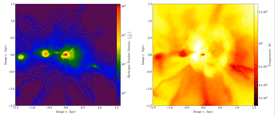It is believed that the first stars formed about 100 million years after the Big Bang from
 "Galactic Archeology" refers to the studystars of the second generation in order to learn about the physical characteristics of the first stars, which disappeared just tens of millions of years after the Big Bang. As part of the study of computational physics, faint supernovae of metal-free first stars were simulated for the first time, which made it possible to reveal the patterns of carbon abundance for star formation. A slice of the density, temperature, and carbon content for the 13-solar-mass progenitor model at times (from left to right) 0.41, 15.22, and 29.16 million years after a supernova explosion in a box with a side of 2 kpc. Credit: Chiaki et al.
"Galactic Archeology" refers to the studystars of the second generation in order to learn about the physical characteristics of the first stars, which disappeared just tens of millions of years after the Big Bang. As part of the study of computational physics, faint supernovae of metal-free first stars were simulated for the first time, which made it possible to reveal the patterns of carbon abundance for star formation. A slice of the density, temperature, and carbon content for the 13-solar-mass progenitor model at times (from left to right) 0.41, 15.22, and 29.16 million years after a supernova explosion in a box with a side of 2 kpc. Credit: Chiaki et al.
When the first metal-free stars collapsed andexploded, turning into supernovae, they formed heavier elements such as carbon. This gave rise to a new generation of stars. One type of second generation of stars is called high carbon lean metal (EMP) stars. To astrophysicists, they are like fossils. Their composition reflects nucleosynthesis or fusion of heavier elements of the first stars.
"We can get results from indirectmeasurements to derive the mass distribution of metal-free stars from the elemental abundances of metal-poor stars,” explains Gen Chiaki, a postdoctoral fellow at the Center for Relativistic Astrophysics at the Georgia Institute of Technology.
Chiaki is the lead author of the study that pioneered faint supernovae of metal-free first stars. His work is finally giving scientists a theoretical understanding of their formation.
 An animation showing the process of carbon enrichment andiron from a first-generation supernova with a mass of 50 solar masses. Four panels show density, temperature, carbon and iron content. First, the metals are dispersed almost spherically in the surrounding area (<14 million years after the explosion). The metals then expand in the horizontal direction while the expansion stops in the vertical direction. Eventually, the metals return to the central region, where the next generation of stars are formed. Credit: Chiaki et al.
An animation showing the process of carbon enrichment andiron from a first-generation supernova with a mass of 50 solar masses. Four panels show density, temperature, carbon and iron content. First, the metals are dispersed almost spherically in the surrounding area (<14 million years after the explosion). The metals then expand in the horizontal direction while the expansion stops in the vertical direction. Eventually, the metals return to the central region, where the next generation of stars are formed. Credit: Chiaki et al.
This kind of research is part of the fieldcalled "galactic archeology". Scientists compare this to searching underground for artifacts that tell about the nature of long-gone societies. For astrophysicists, the nature of long-extinct stars can be determined by their fossilized remains.
“We cannot see the very firstgenerations of stars,” explains study co-author John Wise, assistant professor at the Center for Relativistic Astrophysics at the Georgia Institute of Technology. “It's important to look at these 'living fossils' from the early Universe. They have the “fingerprints” of the first stars—chemicals that were formed in supernovae from the first stars.”
 The animation shows a hot bubble created bya simulated supernova of 50 solar masses on a thousand light-year scale. In the center, a dense gas cloud forms again as a result of gravitational compression. The cloud can be enlarged up to several astronomical units. In the most central region, dense clusters are the embryos of stars. The animation shows that supernova explosions can cause carbon stars to form. Credit: Chiaki et al.
The animation shows a hot bubble created bya simulated supernova of 50 solar masses on a thousand light-year scale. In the center, a dense gas cloud forms again as a result of gravitational compression. The cloud can be enlarged up to several astronomical units. In the most central region, dense clusters are the embryos of stars. The animation shows that supernova explosions can cause carbon stars to form. Credit: Chiaki et al.
The simulation that scientists created allowssee where metals come from and how the first stars and their supernovae actually influence these fossils that have survived to this day.
The purpose of this research by scientists is to find outthe origin of elements such as carbon, oxygen and calcium. They are concentrated in repeating cycles of matter between the interstellar medium and the stars. “Our bodies and our planet are made of carbon and oxygen, nitrogen and calcium. Our work is very important to find out the origin of these elements, which make up people,” concludes the author of the study.
Recall Carl Sagan, American astrophysicistand an exobiologist, back in the last century he said that phosphorus in human DNA and iron in his blood come from “star material.”
Read also
The annual mission in the Arctic has ended and the data are disappointing. What awaits humanity?
Watch the new Hummer overcome obstacles on the road, moving like a crab
On day 3 of illness, most COVID-19 patients lose their sense of smell and often suffer from a runny nose